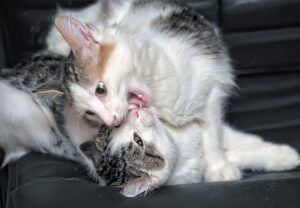Keep Your Cat Away from the Cocoa Mulch!
Do you allow your cat in the backyard? And do you use cocoa mulch in and around your flower beds? Keep him away from it! Cocoa mulch contains theobromine — the same ingredient that makes chocolate off-limits for cats. Ingesting it can make a cat very sick and is potentially lethal. Tufts-trained veterinarian Nahvid Etedali, DVM, points out that cocoa mulch even smells like chocolate, which a cat might find enticing — all the more reason to make sure your pet doesn’t get anywhere near it.
Surgical Care Begins Before the Surgery — At Home
Keeping your cat calm before surgery will make the operation safer. That’s because a calm cat needs a lower dose of anesthetic drugs than a nervous one, and the lower the dose necessary, the better for the patient.
The Feline Anesthesia Guidelines recommend that fearful cats (and many cats are fearful or anxious about going to the vet) should be given 50 to 100 milligrams of gabapentin or another sedative 2 to 3 hours before surgery. The organization says, too, that all staff at the veterinary hospital should be trained in feline-friendly techniques — no scruffing of the neck to hold or carry a cat, for instance. All veterinary health professionals in the office — not just the vet but also the supporting staff — should be conscientious about keeping your pet soothed.

Sometimes what looks ferocious is all in good fun.
Are They Play Fighting, or Just Plain Fighting?
Your two cats are going at it on the floor. It’s as if they’re in the ring wrestling, stopping only for short pauses. Maybe one even has the other pinned for a moment. Are they fighting?
Probably not, according to assessments of feline-to-feline interactions in more than 100 video clips observed by researchers at the University of Veterinary Medicine and Pharmacy in Košice, Slovakia. Wrestling was found to be playful. Not so chasing (especially if only one of the cats was being chased) and vocalizing (including growling or hissing). Those were found to be associated with aggression.
Sometimes, not surprisingly, there was a mixture of behaviors. These included activities that lasted for a prolonged period with pauses in between — pouncing, stalking, and even grooming the other cat. What to make of that? Just as with children who play fight, those in-the-middle moves can get out of hand. Such actions could sometimes indicate that one cat wants to keep going and is imploring the other to “get back in the ring,” while the other has had enough.
In such situations, it falls to you as cat “parent” to gauge when high-spiritedness might cross the line into fighting and help your cats avoid an escalation in aggressive behavior that might get dangerous.
The investigators caution that one episode of interaction does not a relationship make. You have to figure out your pets during multiple interactions over time.



